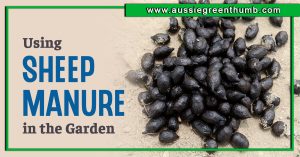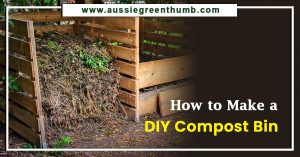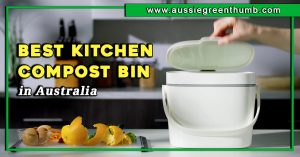Coconut coir is a perplexing planting medium, but it's worth getting to know if you want to grow healthy seedlings or dabble in hydroponics because, above all of its other attributes, it’s an inert substrate (more on that later) which makes it super simple to control the nutrient levels that each plant needs.
In this guide, we’ll demystify some common misunderstandings about coconut coir, explain where it comes from and how it's processed, as well as looking at the best ways to buy it and how to use it to maximum effect.
More...
What is Coconut Coir?
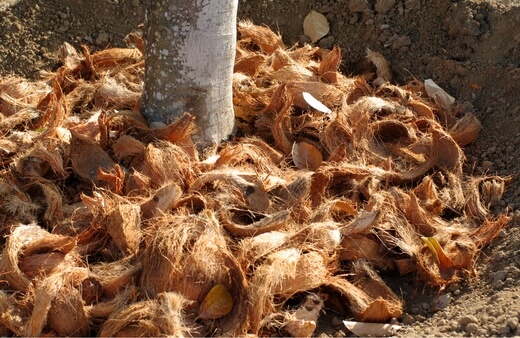
Coconut coir is an inert growing medium derived from the fibrous layer around a coconut’s hard shell, usually sold in compacted bales. Coconuts grow in several fascinating layers, from the central liquid, or milk, which is then surrounded by a layer of white flesh, and a hard shell.
Before the fruit we recognise as a coconut reaches our shelves, that hard shell is coated in several inches of fibrous material called coir, which begins life as a green fibre, and matures into a wiry, hairy brown mass. That is, finally, coated in a soft green outer skin.
The only purpose of the coir in nature is to protect the inner fruit from harm, so it doesn’t waste nutrients on developing it, and instead grows as a nutrient-free fibre.
How is Coconut Coir Made?
Once the coconuts have been harvested, and the shells, flesh, and milk removed, the layer of fibrous coconut coir is processed in water baths to soften. The process is faster using salt water, but this then adds the process of flushing the salt later on, so it’s best to use fresh water where possible.
After they have been loosened up in water, the coconut coir is dried (either artificially in a matter of days, or naturally for twelve months or more. Once dry, coconut coir is graded into sizes, and then ground, sterilised, and packed for horticultural use.
Different Types of Coconut Coir
Because coconut coir can be processed to different levels, it’s available in a few different forms, and all of them take a few years to break down, making for a good long-lasting, reusable planting medium, or soil additive.
The three main types of coconut coir are coco peat (also called coco pith), coco fibre, and coco chips.
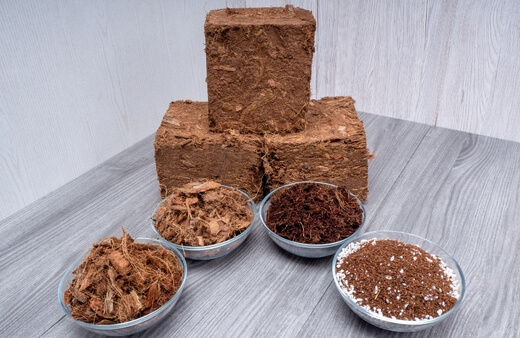
Coco Peat & Coco Pith
Coco peat, or coco pith, is the most usable form of coconut coir, as it can be used as a planting medium all by itself, and it’s great for seedlings that like low nutrients to germinate, or as a gentle, soil loosening mulch, which worms will help to work down into the soil.
Coco peat comes in compacted bales, or vacuum-packed blocks, and loosens up by scraping or wetting, usually increasing in volume by about ten times.
Coco Fibre
Coco fibre is the undersung hero of the coconut coir world. It’s a loosely strung mesh of fibres, often sold in bales. Coconut fibre breaks down completely in the oil after about three years, but in that time it can help to improve the aeration of clay soils, and bind together loose sandy soils around the roots of newly planted shrubs.
For houseplants, adding coco fibre to their planting medium when you pot them onto bigger containers is a useful way to ensure they won’t be sat in boggy conditions too.
Coco Chips
Coco chips are less processed than coco fibre or coco peat, meaning that they still hold together as a structural part of the soil, and unlike the other two, they actively absorb moisture, making them ideal for dry soil where water retention is a problem.


Get Your Free Guide:
Master Growing Australian Natives eBook
A Must Have Complete Guide for Every Australian Garden
Get Your Free Guide:
Master Growing Australian Natives eBook
A Must Have Complete Guide for Every Australian Garden
Adding a mulch of coco chips, or digging them through soil helps to conserve moisture that the surrounding soil can call on when it dries out, like a natural water retention crystal!
Because coco chips are still intact, and simply sliced into chips from their natural form, they break down more slowly and have lasting impacts on your soil quality for up to five years.
How to Use Coconut Coir
There are many ways to use coconut coir, but in essence, they all share two major traits:
- Soil improvement (loosening and aeration)
- Water retention (to increase and decrease)
With that in mind, let’s take a look at some practical ways to utilise this multipurpose soil replacement and additive.
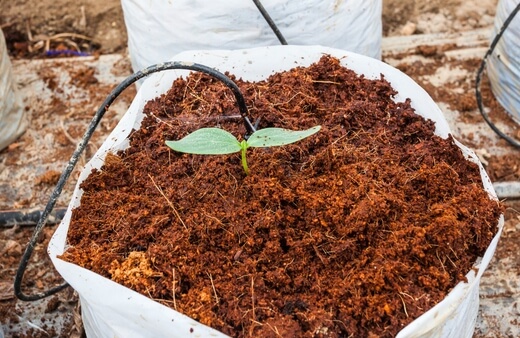
Using Coco Coir for Houseplants
You can use any type of coconut coir for your houseplants, but coco peat is the most common. Tropical houseplants in particular are often overwatered and overfed. Using an inert planting medium, like coconut coir, means that the soil can regulate its own moisture levels, and hold onto the nutrients you choose to feed it, without becoming saturated.
For moisture-loving houseplants, coco chips are ideal mixed into the soil and work well for orchids as a replacement for bark chips. For drought-tolerant plants, coco fibre can be mixed through your potting soil to improve aeration and drainage and can be replaced when you pot on your plants every few years.
Using Coconut Coir for Seedlings
Believe it or not, most seeds you plant don’t actually benefit from nutrient-rich soil. At their germination stage, all your seedlings need is the right amount of moisture, and a substrate to grip their young roots onto.
As they develop, you can add nutrients with their water, or by planting them into bigger pots with compost, but to get your seedlings off to a reliable start, plant them in a tray of expanded coir peat.
Improving Soil Structure
Coconut coir isn’t just useful for indoor plants and potted plants, it’s an excellent soil additive for the garden, and completely organic. If you have damp, heavy clay soil then digging through plenty of coco fibre is a sure way to loosen it up. In a few years, the coir fibre will have broken down, and you’ll have healthier soil.
If you’ve got loose, sandy soil that drains too quickly, add a mulch of coco chips, or dig a bag of coco chips through the soil to add moisture retention that lasts for years, and helps to add natural matter to the soil even once it’s rotted down.
Using Coconut Coir for Vermicomposting
If you’ve ever tried vermicomposting you’ll know the importance of bedding for your worms. Vermicomposting, for anyone new, is just a compost unit that utilises worms to speed up the process, creating liquid fertiliser and worm castings full of goodness.
Because coco fibre is slow to break down it provides a gorgeous habitat for the worms to rest in and helps to filter the compost tea too.
Using Coco Coir for Pots
If you’ve ever seen those little coco coir pots in garden centres, they’re actually really fantastic. You can sow seeds directly into them, and then simply slice the edges before planting them into the ground with the pot still intact.
They’re made from a mixture of coco pith and coco fibre for stability, and break down just slowly enough for your plants to develop.
Using Coconut Coir for Hydroponics
Hydroponics relies on largely inert planting mediums, which means soil or soil substitutes that have no internal nutrients. The best inert substrates are those that can then hold onto added nutrients, like coconut coir.
Using coconut fibre, or coco peat means you can stuff your planting modules full before sowing directly, or wrap it around the root structure of young plants to give them a solid growing medium that water can flow through and past.
Coconut Coir Frequently Asked Questions
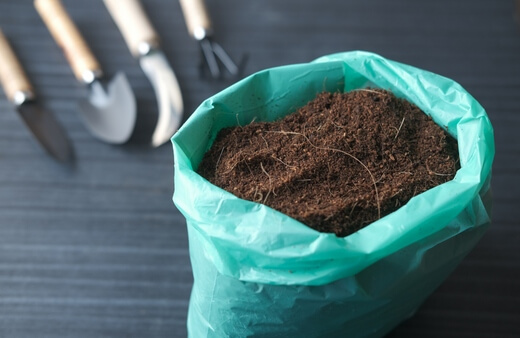
What are the disadvantages of coconut coir?
Two disadvantages of coconut coir are that it can have quite a high salt content, particularly in cheaper products from less reputable brands, so check any reviews before buying online.
It is also an inert growing medium, which can be a positive, but is also a negative as you will need to invest in liquid fertilisers.
Is coconut coir better than soil?
Coconut coir dries out faster than soil and does not have any internal nutrients, so is not a direct replacement for soil. For seedlings, coconut coir can produce more reliable results, but in mature plants, should be used to add to the soil, rather than replace it entirely.
What plants grow best in coconut coir?
Tomato and pepper seedlings have the clearest positive reaction to growing in coconut coir, but if you want a plant that can live its entire life happily in just coconut coir, look to epiphytic plants like bromeliads, which fasten their roots to coconut coir, and get their nutrients from the water and the air.
Does coconut coir go mouldy?
Added sugars in your fertiliser liquids, and over-watering can lead to mouldy coconut coir, especially in bathrooms and kitchens where there is higher humidity. If you notice mould on the surface of coconut coir, wipe it down with a very small amount of vinegar and leave it to dry.
Can bugs live in coconut coir?
Bugs love coconut coir, especially when it’s damp and humid. Partly, that’s why it makes such good bedding for worms, but it can be a pain if you have existing gnat populations, as they will invariably take nests in your coir pots. Avoid overwatering, and it shouldn’t be a problem.
Can you overwater plants in coconut coir?
Coconut coir can be overwatered. While it will naturally drain better than soil or compost, it can still hold onto moisture, so watering too regularly, or leaving it in wet trays will cause waterlogging.
Should you let coconut coir dry out?
If you’ve finished using your coconut coir for the year, you can either wash it and then dry it, or just dry it out in the greenhouse before packaging it up somewhere safe for winter. That way, you can use it again the following year.
Can you put coconut coir on top of soil?
Coconut coir, particularly in its coco chip form, is a great mulch that can be added to the top of soil in pots or out in the garden border. Its excellent moisture retention is useful as a mulch in summer, and can be scraped back in winter or dug into the soil once it’s done its job.
Can worms live in coconut coir?
Not only can worms live in coconut coir, but they can thrive. Coconut coir fibre, and coir peat is a brilliant bedding for worms in vermicomposters and will improve the drainage and lifespan of your worm farm.
How long does coconut coir last in soil?
Depending on the structure of coconut coir it can last up to five years in the soil. Coco chips last longest and continue to improve the soil long after they rot down, but even coco peat will have a noticeable impact on your soil structure after several years.
How many times can you reuse coconut coir?
You can use coco coir as often as you like. While it tends to break down after four years, it's well worth recycling your coir fibre and coir peat after every use, as you can grow several generations of seedlings on the same growing medium in a single year.
Do roots grow through coir pots?
In theory, roots should just grow through coir pots, but I’ve found that they often need a little help. Pierce the sides of coir pots before planting into the ground, or slice them at the base to allow roots easier access to the soil.
Young plants can struggle to pierce the sides of these pots, and it really depends on what plant you are trying to grow.
Wrapping Up Our Coconut Coir Guide
Coconut coir is a gloriously simple material for any gardener to use and makes a neat job of supporting seedlings, developing better soil structure, and improving water retention. Whatever problem your garden is throwing at you this year, I guarantee that there is some form of coconut coir somewhere that can help to solve it.
Published on February 7, 2023 by Gary Clarke
Last Updated on September 20, 2024

